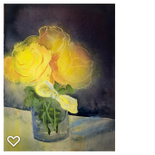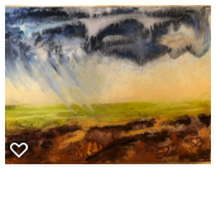| Red Wall | Julia was raised in Cleveland, Ohio, by parents who were amateur painters and ardent museum goers. Visiting the Cleveland Museum of Art was a favorite pastime, and Julia spent many hours sketching in the galleries as a child and docenting there as a teenager. Curiosity to understand the processes that formed the earth' surface lead Julia to the study of geology, and she earned a BA from Bryn Mawr College in 1967 and a PhD in geology from the University of Illinois at Urbana-Champaign in 1975 before getting a job as a hydrologist with the United States Geological Survey. In Illinois, and later in Arizona, she worked along rivers, observing the flow and sediment movement. Julia has had a love of the west since visiting as a child with her family, so when she had the opportunity to move to Arizona and work on the Colorado River in Grand Canyon, she and her husband jumped at the chance to move to Tucson. She spent 15 years collecting data on sediment transport and river flow in the Grand Canyon. During that time, she made extensive use of vertical aerial photographs in her work, and this view of the river from above has given her a unique perspective that is evident in her paintings, many of which are inspired by the Colorado River. Julia has taken classes in drawing, painting and color theory at the Tucson Museum of Art School and Pima Community College and has studied with Tucson artist Deanna Thibault. She joined the Southern Arizona Watercolor Guild in 1997 and became a signature member in 2009. In 1999, she retired from her job as a scientist to devote more time to her art. Workshops with national watercolor artists, including Diane Maxey, Ted Nuttall, Don Getz, Don Andrews, and Timothy Clark all helped develop her skills and personal expression as a painter. Independent study with the internationally acclaimed artist Katherine Chang Liu has provided further artistic development. Julia loves landscapes and usually paints them without any man-made features. Although her landscapes, frequently shown in aerial view, reflect her experience as a geologist/hydrologist, they depict a sense of place and time rather than any actual place. Julia began using pastels while leading an art group at the Aphasia Center of Tucson. After experimenting with various mediums, Julia found pastels were the best for short sessions with students who had the physical and/or cognitive impairments from brain injuries. These sessions, and a sister who is a pastel artist, inspired her to continue exploring the medium. She began playing with smart phone and tablet apps for creating art at the same time and using them as planning tools in her own work as well as an alternative medium for the aphasia students. |






 RSS Feed
RSS Feed